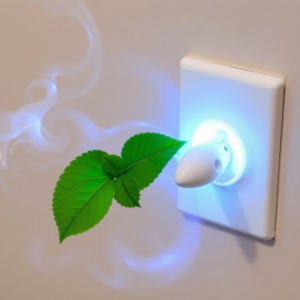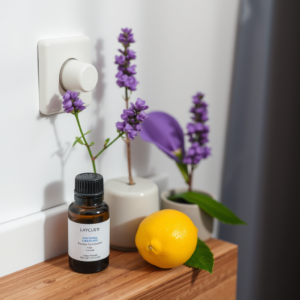Are Plug in Air Fresheners Safe?
A Closer Look at the Facts
In the quest to maintain a fresh and inviting home environment, most of the people use plug-in air fresheners because they are easy to use and come with decent fragrances. Nonetheless, beneath the fascinating fragrances, there lays an increasing worry, are plug-in air fresheners toxic ? are these highly-used items within the household be more of a nuisance than a remedy? With the increasing awareness regarding indoor air quality and exposure to a number of chemicals, there are inquiries regarding the safety of plug-in air fresheners especially their toxicity levels. In this exploration of plug-in air fresheners, we delve into the potential health impacts and safety considerations that every homeowner should know.
 How Do Plug-in Air Fresheners Work?
How Do Plug-in Air Fresheners Work?
Plug-in air fresheners operate by heating a scented oil or gel, causing it to evaporate and release fragrance into the air. Essentially, these appliances are plugged into normal electricity sockets and provide constant fragrance for about weeks. For these reasons, consumers appreciate the ease of operation and the variety of scents provided.
However, It is important to mention the specific materials used in these products. Examples of these are phthalates, terpenes, and VOCs. Phthalates, often used to prolong the scent, have been linked to hormonal disruptions. The exposure of terpenes to ozone has the potential to lead to the development of secondary organic aerosols, which could contribute to pollution levels observed within an enclosed space. Volatile organic compounds are gases that are released from materials or processes, and effects on health may vary with their concentration and the length of time a person is exposed.
Although plug-in air fresheners are easy to use and resolve the problems associated with odors, their composition is a cause for worries from health and environmental perspectives. Understanding what these products contain is the first step in assessing their safety.
Safety Concerns
The question remains—are plug-in air fresheners toxic to humans and pets? Studies suggest that these products can adversely affect indoor air quality and health. For example, inhalation of elevated concentrations of volatile organic compounds (VOCs) can lead to headaches, lightheadedness, irritation of the respiratory tract, and even loss of short-term memory.
Pets, particularly cats and dogs, may also be more sensitive to the chemicals found in plug-in air fresheners. Due to their diminutive stature and position nearer to the ground, they can be more prone to border exposure to given substances which may result into respiratory difficulties or skin rashes. However, the existence of such exposures over time could have more serious implications in health.
As awareness grows about the potential health risks posed by plug-in air fresheners, more people are seeking safer alternatives. While the convenience of these products is undeniable, it’s crucial to weigh this against possible health implications for both humans and pets.
Environmental Impact
Beyond individual health concerns, plug-in air fresheners also pose significant environmental challenges. Devices such as these tend to augment the already existing indoor air pollution mostly due to the emission of volatile organic compounds and other similar chemicals. These gases when emitted do also interact with already existing pollutants causing the formation of mock haze and litter pollutants which reduce the quality of air.
In addition, air fresheners that plug into electrical outlets pose a risk to the environment during their manufacturing and disposal stages. They consist of plastic and electrical elements, which end up as trash in landfills, whereas the substances inside them can seep through the earth and water sources.
The environmental impact extends to the ozone layer as well. Some air fresheners release substances that can damage the ozone layer, indirectly contributing to climate change. It’s essential to consider these broader consequences when choosing products for our homes.
Expand Alternatives and Solutions
Luckily, there are numerous nature-friendly substitutes for plug-in air fresheners. For instance, essential oil diffusers are an all-natural and hassle-free means of making the home smell good. Scents like lavender, eucalyptus, and lemon are not only nice scents but are also quite possibly aroma therapeutically useful.
Improving indoor air quality doesn’t always require artificial fragrance. Consistently airing out the house, employing indoor plants with air-purifying characteristics, and maintaining clean surfaces help base the level of odor effectively. Natural deodorizers such as baking powder and activated carbon work to eliminate bad smell without the assistance of chemicals.
Simple lifestyle changes, such as avoiding smoking indoors and being mindful of product choices, can also enhance air quality. Choosing natural remedies can help you improve the ambiance of your home or office while reducing your environmental impact.
Conclusion
In conclusion, the safety and environmental impact of plug-in air fresheners are subjects worth considering, especially with the question of “are plug-in air fresheners toxic” at the forefront of discussions. While these products offer undeniable convenience and effectiveness, their potential health risks and environmental consequences cannot be ignored.
For eco-conscious consumers, homeowners, and parents, choosing natural alternatives is a step toward a safer and more sustainable lifestyle. By making informed decisions, we can protect our health, homes, and planet.
We encourage you to share this information with friends and family, fostering awareness and promoting safer choices for everyone. Together, we can enjoy fragrant homes without compromising our well-being or the environment.
In the quest to maintain a fresh and inviting home environment, most of the people use plug-in air fresheners because they are easy to use and come with decent fragrances. Nonetheless, beneath the fascinating fragrances, there lays an increasing worry: may these highly-used items within the household be more of a nuisance than a remedy? With the increasing awareness regarding indoor air quality and exposure to a number of chemicals, there are inquiries regarding the safety of plug-in air fresheners especially their toxicity levels. Are these devices silently introducing harmful chemicals into our living spaces? In this exploration of plug-in air fresheners, we delve into the potential health impacts and safety considerations that every homeowner should know.

